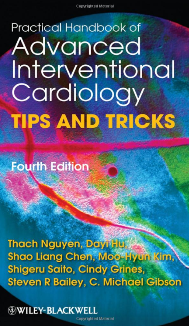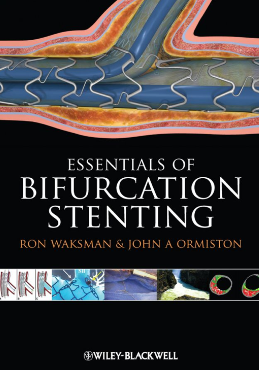Practical handbook of advanced interventional cardiology: tips and tricks (4th edition)
Authors: Nguyen T, Hu D, Chen SL, et al.
Publisher: Wiley-Blackwell, 2012
ISBN: 9780470670477
Price: £62.99
 This helpful, practical guide to interventional cardiology focuses on procedural and technical aspects rather than the overall clinical practice approach usually seen in larger textbooks. It assumes that clinical decision-making prior to starting the procedure has been sound, and approaches things from the perspective of already having a patient on the table.
This helpful, practical guide to interventional cardiology focuses on procedural and technical aspects rather than the overall clinical practice approach usually seen in larger textbooks. It assumes that clinical decision-making prior to starting the procedure has been sound, and approaches things from the perspective of already having a patient on the table.
The content and chapters are fairly comprehensive and logical in their order, with increasingly complex or less commonly performed procedures towards the end of the book. I would have liked a specific chapter on rotational atherectomy and also perhaps one on some adjunctive methods to evaluate stenoses.
The style is generally easy to read and, although the descriptions of certain practical manoeuvres could be hard to follow (and are at times quite lengthy), stepwise illustrations help to explain these. I do think that extensive descriptions were required to adequately explain the use of certain equipment and so on. Despite their length, these probably improve the readers’ chances of successfully employing the techniques themselves.
The ‘tricks and tips’ suggested have sometimes been ranked according to cost, safety, and technical difficulty, which are delineated by symbols throughout the book. Although I didn’t feel this was particularly necessary, as such things may be obvious to most practitioners, I did appreciate this more in the ‘tactical move’ sections. These illustrate a stepwise technical problem-solving approach, starting with the simplest/cheapest and escalating appropriately. The ‘caveat’ sections are also relevant, helpful, and would be of particular use to less experienced operators.
Probably the best aspect of this book is the unbiased and detailed descriptions of contemporary interventional cath lab equipment, with illustrations in many cases. I was impressed with the range of devices that are discussed and the level of detail and practical information regarding their use/limitations. This really was an outstanding feature and would be useful both to trainees employing these for the first time as well as for experienced operators as an ‘aide-mémoire’.
Overall, this is an excellent practical handbook. It is both easy and useful to read sequentially for educational purposes but also has a role as a quick-reference guide. I would certainly recommend it to other interventional trainees and consultants.
Dr Kristel C Longman
ST7 Cardiology
Department of Cardiology, Portsmouth Hospitals NHS Trust
Bifurcation stenting
Editors: Waksman R, Ormiston JA
Publisher: Wiley-Blackwell, 2012
ISBN: 9781444334623
Price: £80.95
 This book provides a state-of-the-art review of the theoretical and practical aspects of bifurcation stenting. The editors have successfully brought together 54 contributors to compile an extensive body of evidence that takes the reader through basic bifurcation techniques, major clinical trials in bifurcation stenting, adjunctive imaging modalities and the rapidly expanding field of dedicated bifurcation stents. The organisation is meticulous, the layout is exquisite and the text is packed with robust scientific evidence.
This book provides a state-of-the-art review of the theoretical and practical aspects of bifurcation stenting. The editors have successfully brought together 54 contributors to compile an extensive body of evidence that takes the reader through basic bifurcation techniques, major clinical trials in bifurcation stenting, adjunctive imaging modalities and the rapidly expanding field of dedicated bifurcation stents. The organisation is meticulous, the layout is exquisite and the text is packed with robust scientific evidence.
The first chapter introduces the reader to the classification of bifurcation stenting. This is followed by five chapters on the several available techniques and landmark trials that have helped shape clinical practice in recent years. Importantly, a separate chapter is dedicated to left main stem bifurcation stenting. All major trials are described in a careful, structured manner, educating the reader about the evidence that each trial contributed.
The following seven chapters describe the use of adjunctive imaging modalities – for example, intravascular ultrasound and optical coherence tomography – in bifurcation stenting. Other chapters cover the basic pathophysiology of plaque development at coronary bifurcations, principles of bench model testing, and the role of quantitative angiography.
The final six chapters take the reader through the exciting and rapidly expanding field of dedicated bifurcation platforms. Each dedicated bifurcation stent has a separate chapter that describes the device, the method of deployment and indications for use. As these devices are relatively new, careful attention has been given to provide a step-bystep approach on the methodology and indications for each dedicated bifurcation stent. Each chapter also includes up-to-date scientific evidence summarising mechanistic and population-based prospective studies.
My only criticism is that some of the black and white angiogram images can be difficult to appreciate and perhaps can be improved upon in any subsequent editions. Finally, a notable omission from the book is the TrytonTM stent which has gained approval for clinical use in bifurcation lesions and is currently being investigated in a left main stem registry.
The editors and contributors ought to be congratulated in providing such an in-depth yet easy-to-read book on this subject, which will undoubtedly serve as an excellent and timely addition to the field of interventional cardiology.
Dr Omar Rana
Fellow in Interventional Cardiology
Royal Bournemouth Hospital, Bournemouth BH7 7DW
